Business Law Report: Direct and Indirect Effects of EU Law
VerifiedAdded on 2022/09/09
|11
|2963
|18
Report
AI Summary
This report examines the direct and indirect effects of EU law, focusing on two scenarios. The first scenario analyzes whether John has rights under EU law, considering the principle of direct effect, as established in Van Gend en Loos. It discusses the criteria for direct effect and its application to a case where John is injured due to non-compliance with an EU directive. The second scenario explores whether Anne-Marie has rights under EU law, focusing on the principle of indirect effect. It examines the concept of indirect effect, the role of national courts in interpreting national laws in line with EU law, and the implications of a member state's failure to implement an EU directive, referencing cases like Marleasing SA v La Comercial Internacional de Alimentación SA and Von Colson v Land Nordrhein-Westfalen. The report also touches upon state liability and the Francovich principle. Overall, the report provides a detailed analysis of EU law's direct and indirect effects in business law, highlighting their practical implications through the provided scenarios and relevant case laws.
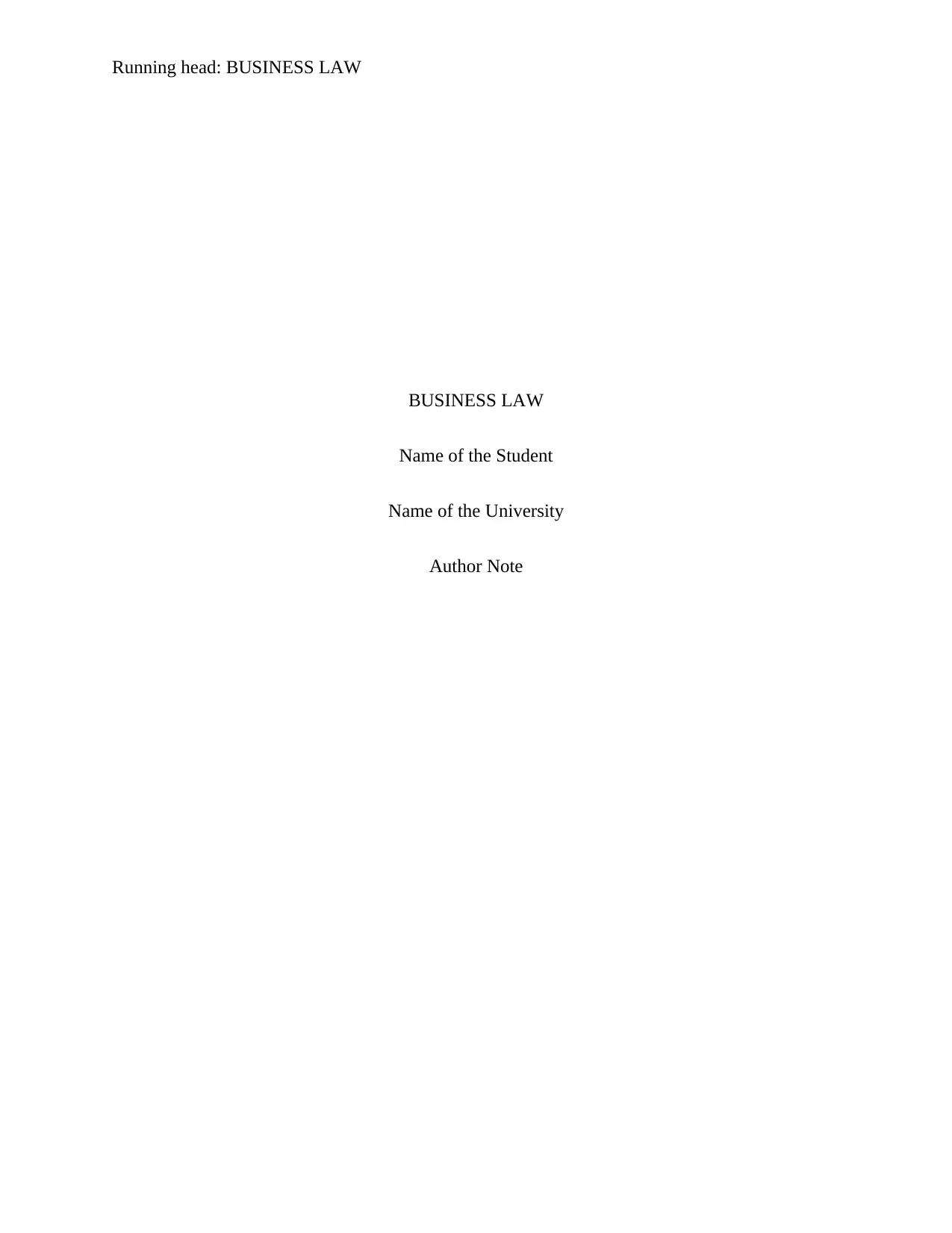
Running head: BUSINESS LAW
BUSINESS LAW
Name of the Student
Name of the University
Author Note
BUSINESS LAW
Name of the Student
Name of the University
Author Note
Paraphrase This Document
Need a fresh take? Get an instant paraphrase of this document with our AI Paraphraser
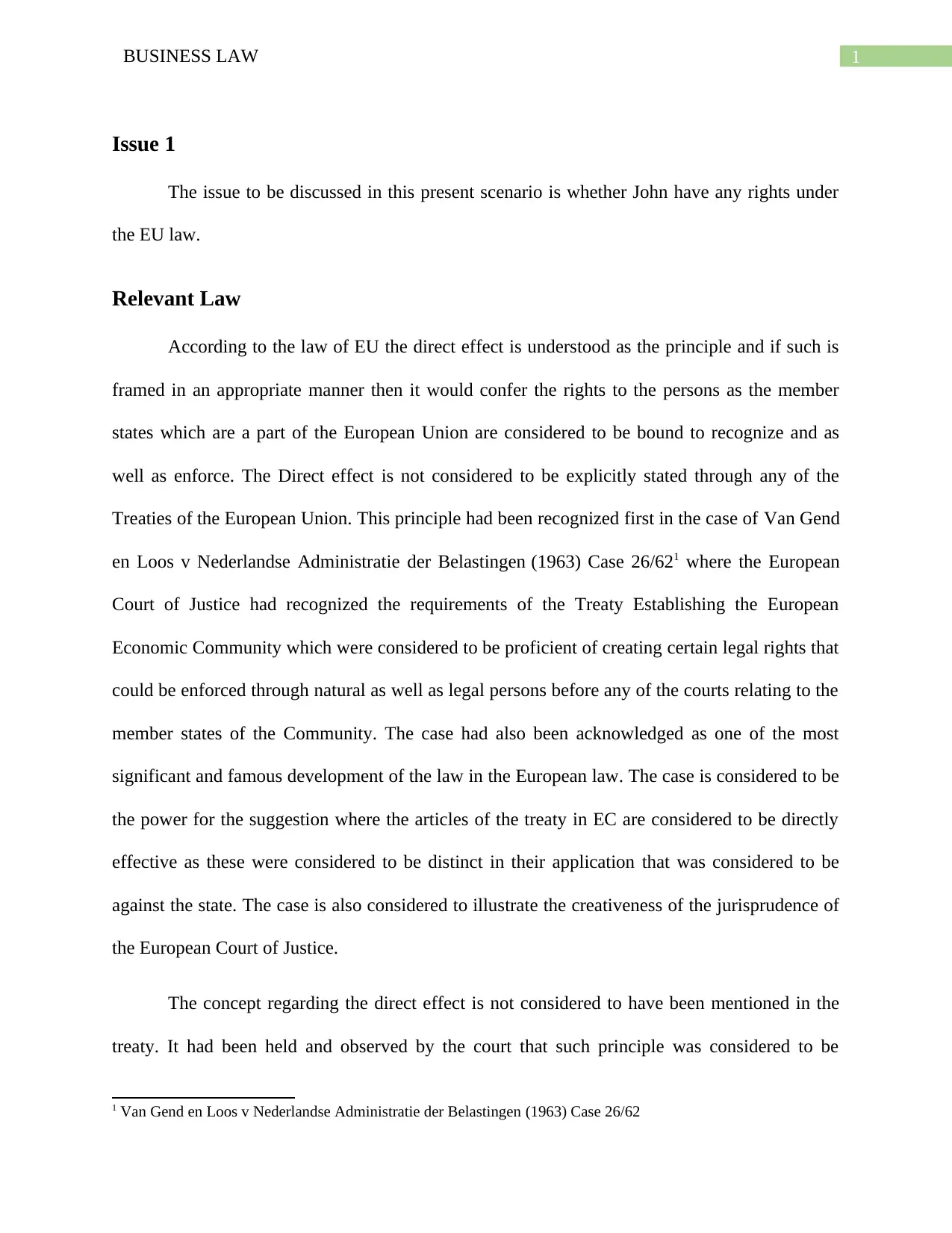
1BUSINESS LAW
Issue 1
The issue to be discussed in this present scenario is whether John have any rights under
the EU law.
Relevant Law
According to the law of EU the direct effect is understood as the principle and if such is
framed in an appropriate manner then it would confer the rights to the persons as the member
states which are a part of the European Union are considered to be bound to recognize and as
well as enforce. The Direct effect is not considered to be explicitly stated through any of the
Treaties of the European Union. This principle had been recognized first in the case of Van Gend
en Loos v Nederlandse Administratie der Belastingen (1963) Case 26/621 where the European
Court of Justice had recognized the requirements of the Treaty Establishing the European
Economic Community which were considered to be proficient of creating certain legal rights that
could be enforced through natural as well as legal persons before any of the courts relating to the
member states of the Community. The case had also been acknowledged as one of the most
significant and famous development of the law in the European law. The case is considered to be
the power for the suggestion where the articles of the treaty in EC are considered to be directly
effective as these were considered to be distinct in their application that was considered to be
against the state. The case is also considered to illustrate the creativeness of the jurisprudence of
the European Court of Justice.
The concept regarding the direct effect is not considered to have been mentioned in the
treaty. It had been held and observed by the court that such principle was considered to be
1 Van Gend en Loos v Nederlandse Administratie der Belastingen (1963) Case 26/62
Issue 1
The issue to be discussed in this present scenario is whether John have any rights under
the EU law.
Relevant Law
According to the law of EU the direct effect is understood as the principle and if such is
framed in an appropriate manner then it would confer the rights to the persons as the member
states which are a part of the European Union are considered to be bound to recognize and as
well as enforce. The Direct effect is not considered to be explicitly stated through any of the
Treaties of the European Union. This principle had been recognized first in the case of Van Gend
en Loos v Nederlandse Administratie der Belastingen (1963) Case 26/621 where the European
Court of Justice had recognized the requirements of the Treaty Establishing the European
Economic Community which were considered to be proficient of creating certain legal rights that
could be enforced through natural as well as legal persons before any of the courts relating to the
member states of the Community. The case had also been acknowledged as one of the most
significant and famous development of the law in the European law. The case is considered to be
the power for the suggestion where the articles of the treaty in EC are considered to be directly
effective as these were considered to be distinct in their application that was considered to be
against the state. The case is also considered to illustrate the creativeness of the jurisprudence of
the European Court of Justice.
The concept regarding the direct effect is not considered to have been mentioned in the
treaty. It had been held and observed by the court that such principle was considered to be
1 Van Gend en Loos v Nederlandse Administratie der Belastingen (1963) Case 26/62
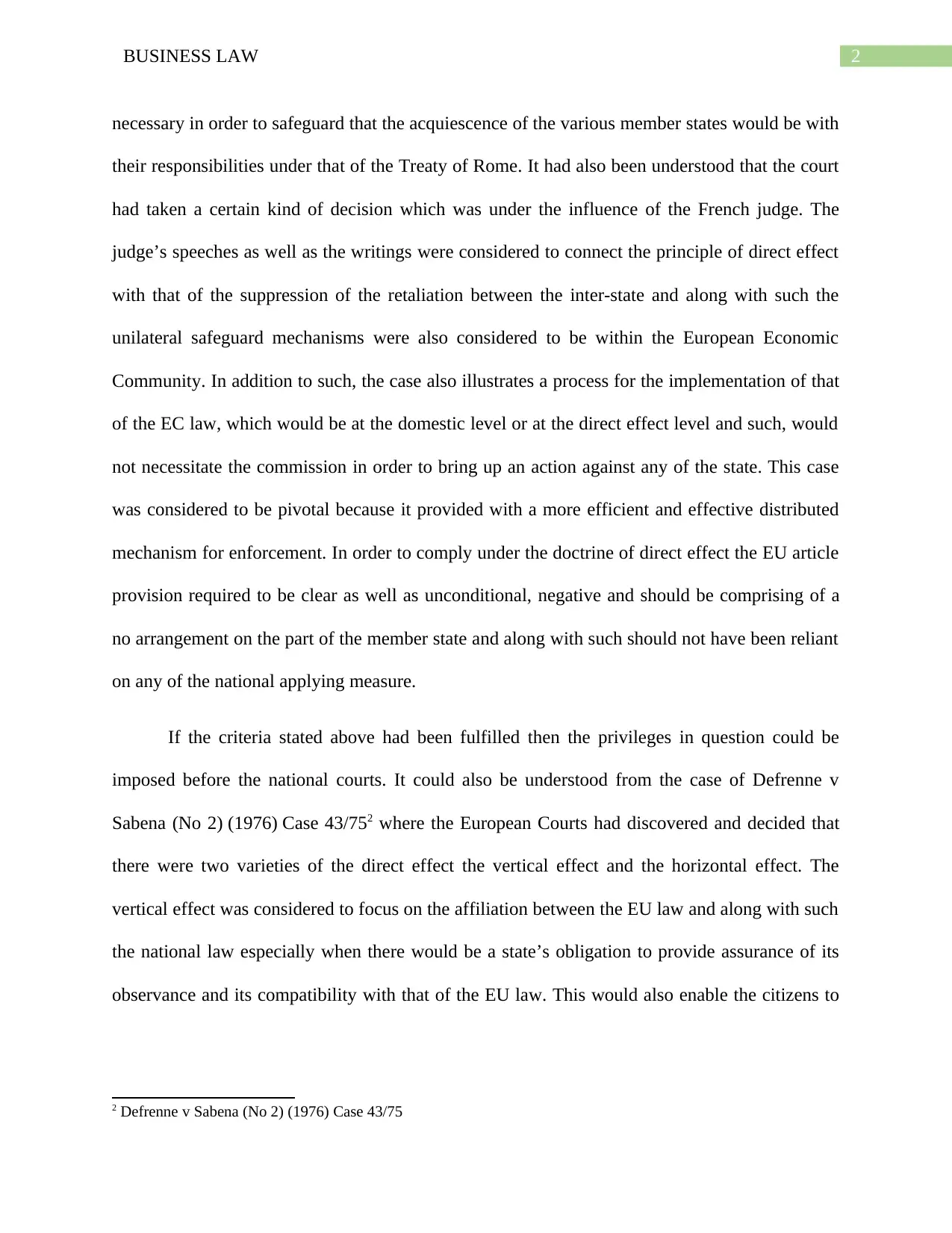
2BUSINESS LAW
necessary in order to safeguard that the acquiescence of the various member states would be with
their responsibilities under that of the Treaty of Rome. It had also been understood that the court
had taken a certain kind of decision which was under the influence of the French judge. The
judge’s speeches as well as the writings were considered to connect the principle of direct effect
with that of the suppression of the retaliation between the inter-state and along with such the
unilateral safeguard mechanisms were also considered to be within the European Economic
Community. In addition to such, the case also illustrates a process for the implementation of that
of the EC law, which would be at the domestic level or at the direct effect level and such, would
not necessitate the commission in order to bring up an action against any of the state. This case
was considered to be pivotal because it provided with a more efficient and effective distributed
mechanism for enforcement. In order to comply under the doctrine of direct effect the EU article
provision required to be clear as well as unconditional, negative and should be comprising of a
no arrangement on the part of the member state and along with such should not have been reliant
on any of the national applying measure.
If the criteria stated above had been fulfilled then the privileges in question could be
imposed before the national courts. It could also be understood from the case of Defrenne v
Sabena (No 2) (1976) Case 43/752 where the European Courts had discovered and decided that
there were two varieties of the direct effect the vertical effect and the horizontal effect. The
vertical effect was considered to focus on the affiliation between the EU law and along with such
the national law especially when there would be a state’s obligation to provide assurance of its
observance and its compatibility with that of the EU law. This would also enable the citizens to
2 Defrenne v Sabena (No 2) (1976) Case 43/75
necessary in order to safeguard that the acquiescence of the various member states would be with
their responsibilities under that of the Treaty of Rome. It had also been understood that the court
had taken a certain kind of decision which was under the influence of the French judge. The
judge’s speeches as well as the writings were considered to connect the principle of direct effect
with that of the suppression of the retaliation between the inter-state and along with such the
unilateral safeguard mechanisms were also considered to be within the European Economic
Community. In addition to such, the case also illustrates a process for the implementation of that
of the EC law, which would be at the domestic level or at the direct effect level and such, would
not necessitate the commission in order to bring up an action against any of the state. This case
was considered to be pivotal because it provided with a more efficient and effective distributed
mechanism for enforcement. In order to comply under the doctrine of direct effect the EU article
provision required to be clear as well as unconditional, negative and should be comprising of a
no arrangement on the part of the member state and along with such should not have been reliant
on any of the national applying measure.
If the criteria stated above had been fulfilled then the privileges in question could be
imposed before the national courts. It could also be understood from the case of Defrenne v
Sabena (No 2) (1976) Case 43/752 where the European Courts had discovered and decided that
there were two varieties of the direct effect the vertical effect and the horizontal effect. The
vertical effect was considered to focus on the affiliation between the EU law and along with such
the national law especially when there would be a state’s obligation to provide assurance of its
observance and its compatibility with that of the EU law. This would also enable the citizens to
2 Defrenne v Sabena (No 2) (1976) Case 43/75
⊘ This is a preview!⊘
Do you want full access?
Subscribe today to unlock all pages.

Trusted by 1+ million students worldwide
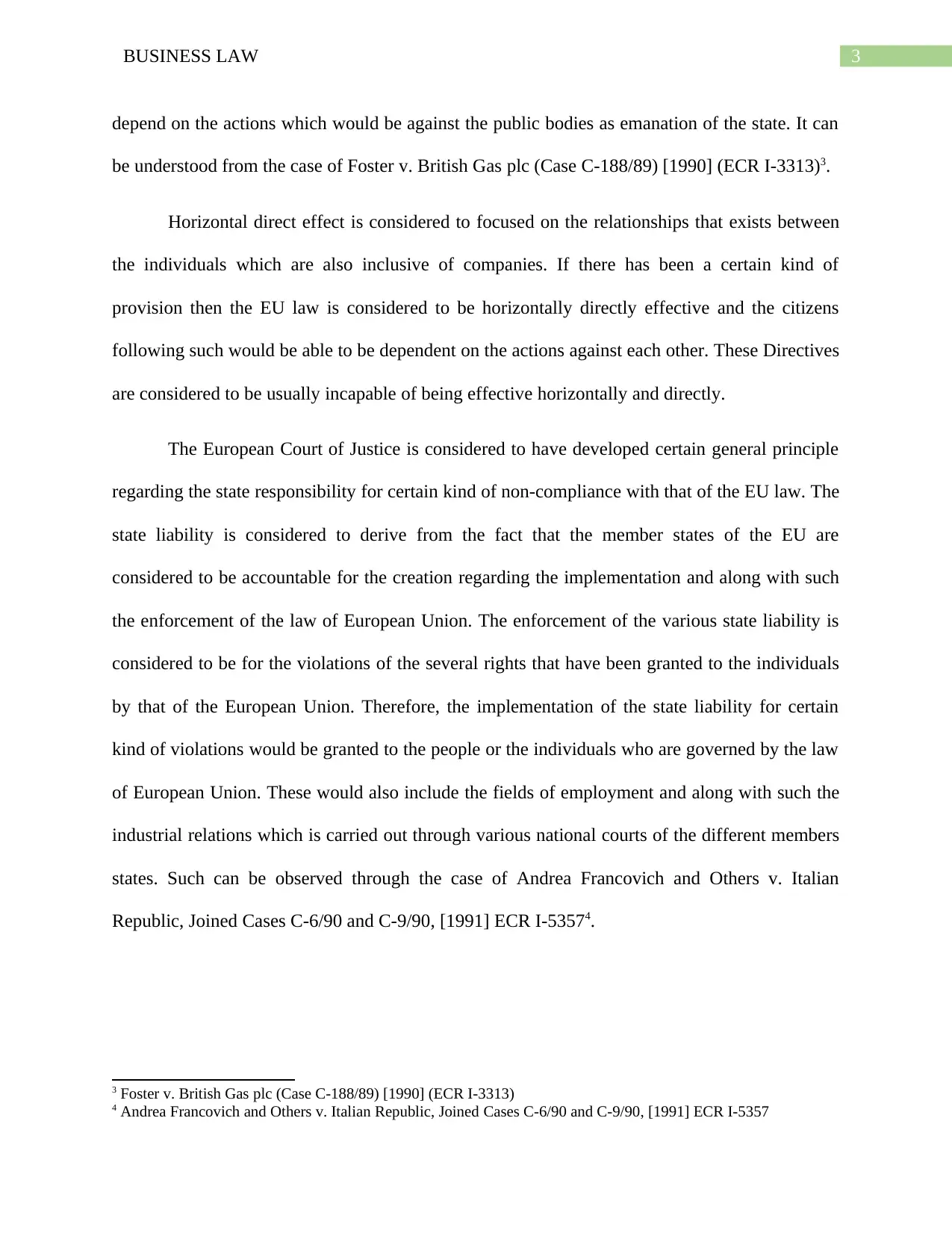
3BUSINESS LAW
depend on the actions which would be against the public bodies as emanation of the state. It can
be understood from the case of Foster v. British Gas plc (Case C-188/89) [1990] (ECR I-3313)3.
Horizontal direct effect is considered to focused on the relationships that exists between
the individuals which are also inclusive of companies. If there has been a certain kind of
provision then the EU law is considered to be horizontally directly effective and the citizens
following such would be able to be dependent on the actions against each other. These Directives
are considered to be usually incapable of being effective horizontally and directly.
The European Court of Justice is considered to have developed certain general principle
regarding the state responsibility for certain kind of non-compliance with that of the EU law. The
state liability is considered to derive from the fact that the member states of the EU are
considered to be accountable for the creation regarding the implementation and along with such
the enforcement of the law of European Union. The enforcement of the various state liability is
considered to be for the violations of the several rights that have been granted to the individuals
by that of the European Union. Therefore, the implementation of the state liability for certain
kind of violations would be granted to the people or the individuals who are governed by the law
of European Union. These would also include the fields of employment and along with such the
industrial relations which is carried out through various national courts of the different members
states. Such can be observed through the case of Andrea Francovich and Others v. Italian
Republic, Joined Cases C-6/90 and C-9/90, [1991] ECR I-53574.
3 Foster v. British Gas plc (Case C-188/89) [1990] (ECR I-3313)
4 Andrea Francovich and Others v. Italian Republic, Joined Cases C-6/90 and C-9/90, [1991] ECR I-5357
depend on the actions which would be against the public bodies as emanation of the state. It can
be understood from the case of Foster v. British Gas plc (Case C-188/89) [1990] (ECR I-3313)3.
Horizontal direct effect is considered to focused on the relationships that exists between
the individuals which are also inclusive of companies. If there has been a certain kind of
provision then the EU law is considered to be horizontally directly effective and the citizens
following such would be able to be dependent on the actions against each other. These Directives
are considered to be usually incapable of being effective horizontally and directly.
The European Court of Justice is considered to have developed certain general principle
regarding the state responsibility for certain kind of non-compliance with that of the EU law. The
state liability is considered to derive from the fact that the member states of the EU are
considered to be accountable for the creation regarding the implementation and along with such
the enforcement of the law of European Union. The enforcement of the various state liability is
considered to be for the violations of the several rights that have been granted to the individuals
by that of the European Union. Therefore, the implementation of the state liability for certain
kind of violations would be granted to the people or the individuals who are governed by the law
of European Union. These would also include the fields of employment and along with such the
industrial relations which is carried out through various national courts of the different members
states. Such can be observed through the case of Andrea Francovich and Others v. Italian
Republic, Joined Cases C-6/90 and C-9/90, [1991] ECR I-53574.
3 Foster v. British Gas plc (Case C-188/89) [1990] (ECR I-3313)
4 Andrea Francovich and Others v. Italian Republic, Joined Cases C-6/90 and C-9/90, [1991] ECR I-5357
Paraphrase This Document
Need a fresh take? Get an instant paraphrase of this document with our AI Paraphraser
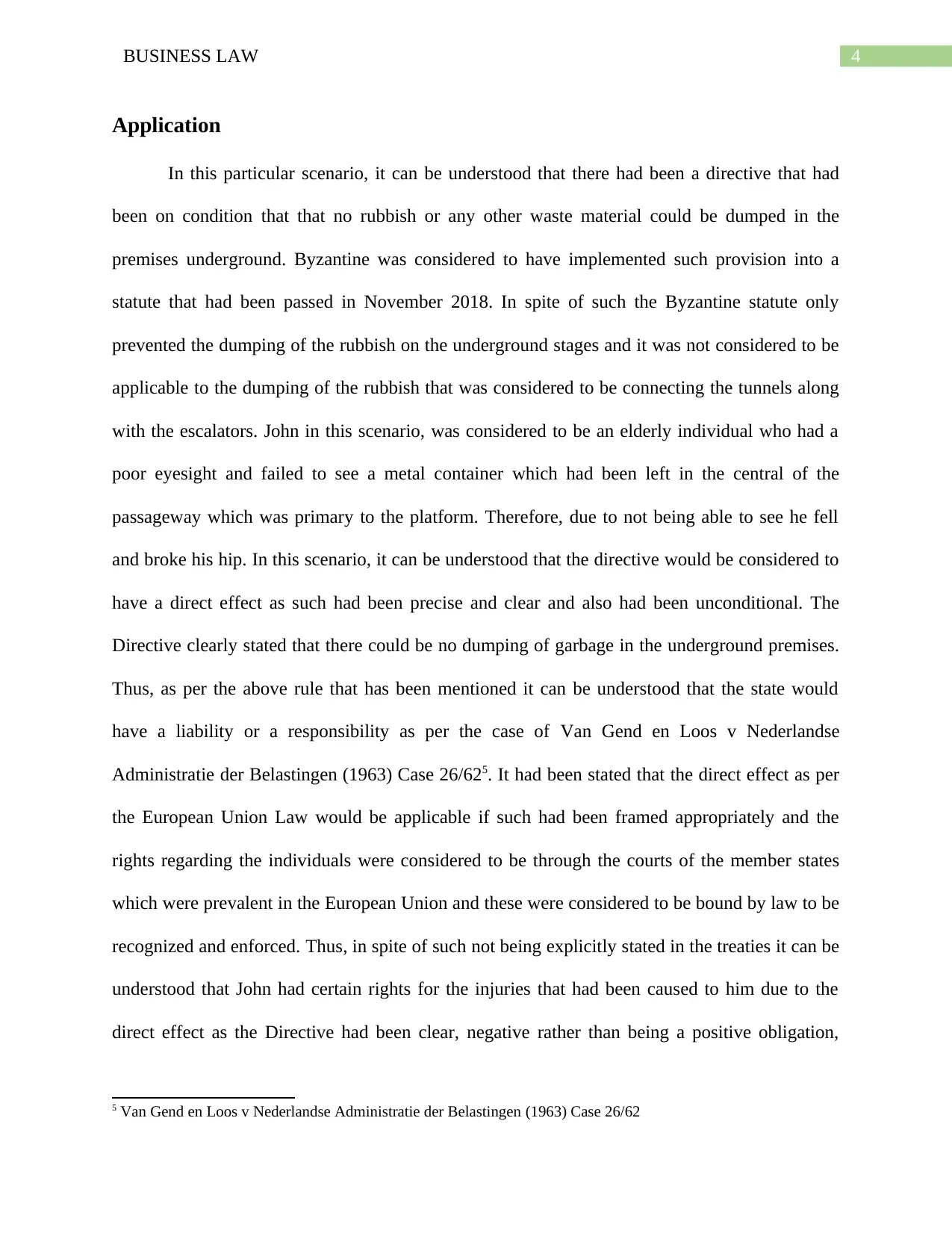
4BUSINESS LAW
Application
In this particular scenario, it can be understood that there had been a directive that had
been on condition that that no rubbish or any other waste material could be dumped in the
premises underground. Byzantine was considered to have implemented such provision into a
statute that had been passed in November 2018. In spite of such the Byzantine statute only
prevented the dumping of the rubbish on the underground stages and it was not considered to be
applicable to the dumping of the rubbish that was considered to be connecting the tunnels along
with the escalators. John in this scenario, was considered to be an elderly individual who had a
poor eyesight and failed to see a metal container which had been left in the central of the
passageway which was primary to the platform. Therefore, due to not being able to see he fell
and broke his hip. In this scenario, it can be understood that the directive would be considered to
have a direct effect as such had been precise and clear and also had been unconditional. The
Directive clearly stated that there could be no dumping of garbage in the underground premises.
Thus, as per the above rule that has been mentioned it can be understood that the state would
have a liability or a responsibility as per the case of Van Gend en Loos v Nederlandse
Administratie der Belastingen (1963) Case 26/625. It had been stated that the direct effect as per
the European Union Law would be applicable if such had been framed appropriately and the
rights regarding the individuals were considered to be through the courts of the member states
which were prevalent in the European Union and these were considered to be bound by law to be
recognized and enforced. Thus, in spite of such not being explicitly stated in the treaties it can be
understood that John had certain rights for the injuries that had been caused to him due to the
direct effect as the Directive had been clear, negative rather than being a positive obligation,
5 Van Gend en Loos v Nederlandse Administratie der Belastingen (1963) Case 26/62
Application
In this particular scenario, it can be understood that there had been a directive that had
been on condition that that no rubbish or any other waste material could be dumped in the
premises underground. Byzantine was considered to have implemented such provision into a
statute that had been passed in November 2018. In spite of such the Byzantine statute only
prevented the dumping of the rubbish on the underground stages and it was not considered to be
applicable to the dumping of the rubbish that was considered to be connecting the tunnels along
with the escalators. John in this scenario, was considered to be an elderly individual who had a
poor eyesight and failed to see a metal container which had been left in the central of the
passageway which was primary to the platform. Therefore, due to not being able to see he fell
and broke his hip. In this scenario, it can be understood that the directive would be considered to
have a direct effect as such had been precise and clear and also had been unconditional. The
Directive clearly stated that there could be no dumping of garbage in the underground premises.
Thus, as per the above rule that has been mentioned it can be understood that the state would
have a liability or a responsibility as per the case of Van Gend en Loos v Nederlandse
Administratie der Belastingen (1963) Case 26/625. It had been stated that the direct effect as per
the European Union Law would be applicable if such had been framed appropriately and the
rights regarding the individuals were considered to be through the courts of the member states
which were prevalent in the European Union and these were considered to be bound by law to be
recognized and enforced. Thus, in spite of such not being explicitly stated in the treaties it can be
understood that John had certain rights for the injuries that had been caused to him due to the
direct effect as the Directive had been clear, negative rather than being a positive obligation,
5 Van Gend en Loos v Nederlandse Administratie der Belastingen (1963) Case 26/62
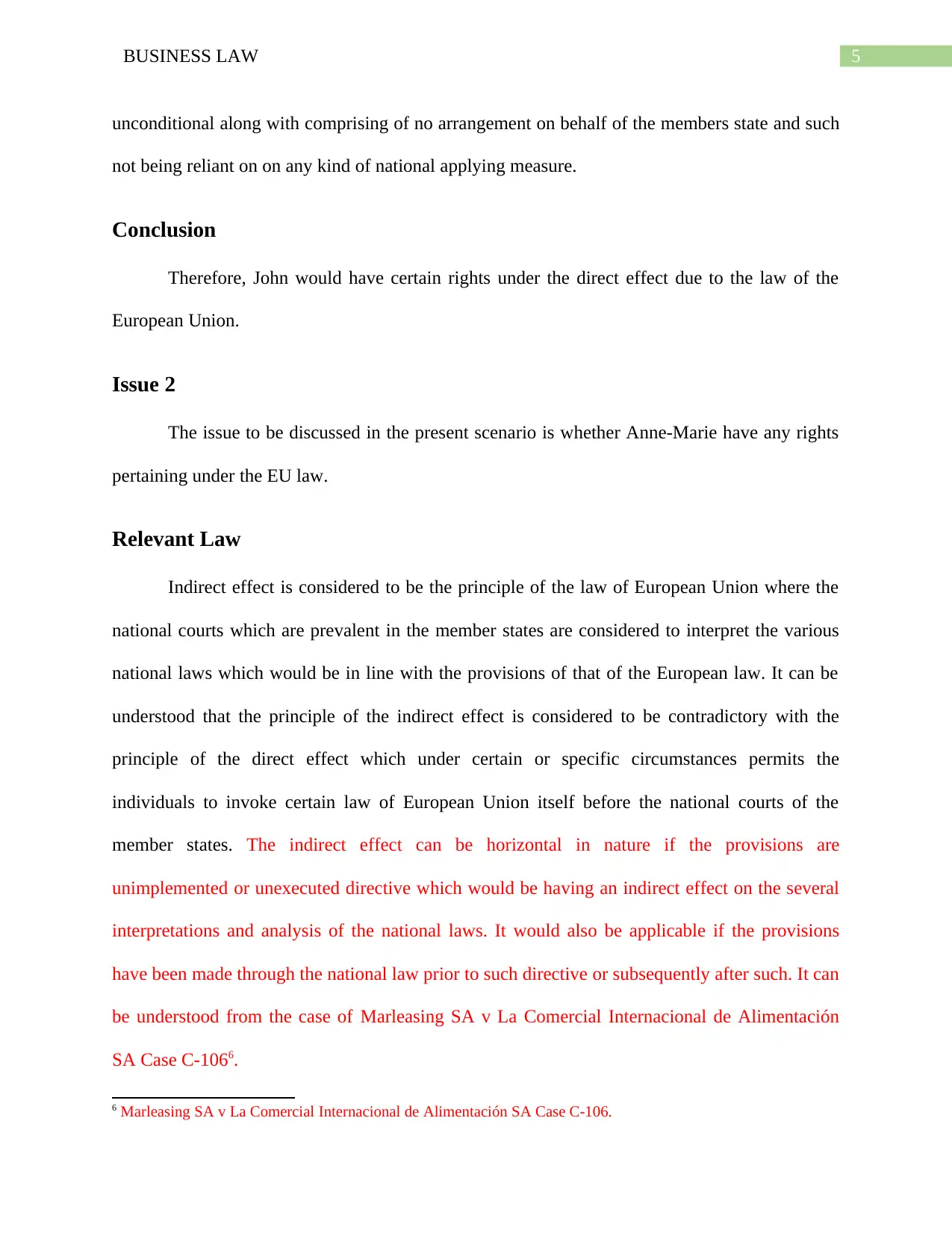
5BUSINESS LAW
unconditional along with comprising of no arrangement on behalf of the members state and such
not being reliant on on any kind of national applying measure.
Conclusion
Therefore, John would have certain rights under the direct effect due to the law of the
European Union.
Issue 2
The issue to be discussed in the present scenario is whether Anne-Marie have any rights
pertaining under the EU law.
Relevant Law
Indirect effect is considered to be the principle of the law of European Union where the
national courts which are prevalent in the member states are considered to interpret the various
national laws which would be in line with the provisions of that of the European law. It can be
understood that the principle of the indirect effect is considered to be contradictory with the
principle of the direct effect which under certain or specific circumstances permits the
individuals to invoke certain law of European Union itself before the national courts of the
member states. The indirect effect can be horizontal in nature if the provisions are
unimplemented or unexecuted directive which would be having an indirect effect on the several
interpretations and analysis of the national laws. It would also be applicable if the provisions
have been made through the national law prior to such directive or subsequently after such. It can
be understood from the case of Marleasing SA v La Comercial Internacional de Alimentación
SA Case C-1066.
6 Marleasing SA v La Comercial Internacional de Alimentación SA Case C-106.
unconditional along with comprising of no arrangement on behalf of the members state and such
not being reliant on on any kind of national applying measure.
Conclusion
Therefore, John would have certain rights under the direct effect due to the law of the
European Union.
Issue 2
The issue to be discussed in the present scenario is whether Anne-Marie have any rights
pertaining under the EU law.
Relevant Law
Indirect effect is considered to be the principle of the law of European Union where the
national courts which are prevalent in the member states are considered to interpret the various
national laws which would be in line with the provisions of that of the European law. It can be
understood that the principle of the indirect effect is considered to be contradictory with the
principle of the direct effect which under certain or specific circumstances permits the
individuals to invoke certain law of European Union itself before the national courts of the
member states. The indirect effect can be horizontal in nature if the provisions are
unimplemented or unexecuted directive which would be having an indirect effect on the several
interpretations and analysis of the national laws. It would also be applicable if the provisions
have been made through the national law prior to such directive or subsequently after such. It can
be understood from the case of Marleasing SA v La Comercial Internacional de Alimentación
SA Case C-1066.
6 Marleasing SA v La Comercial Internacional de Alimentación SA Case C-106.
⊘ This is a preview!⊘
Do you want full access?
Subscribe today to unlock all pages.

Trusted by 1+ million students worldwide
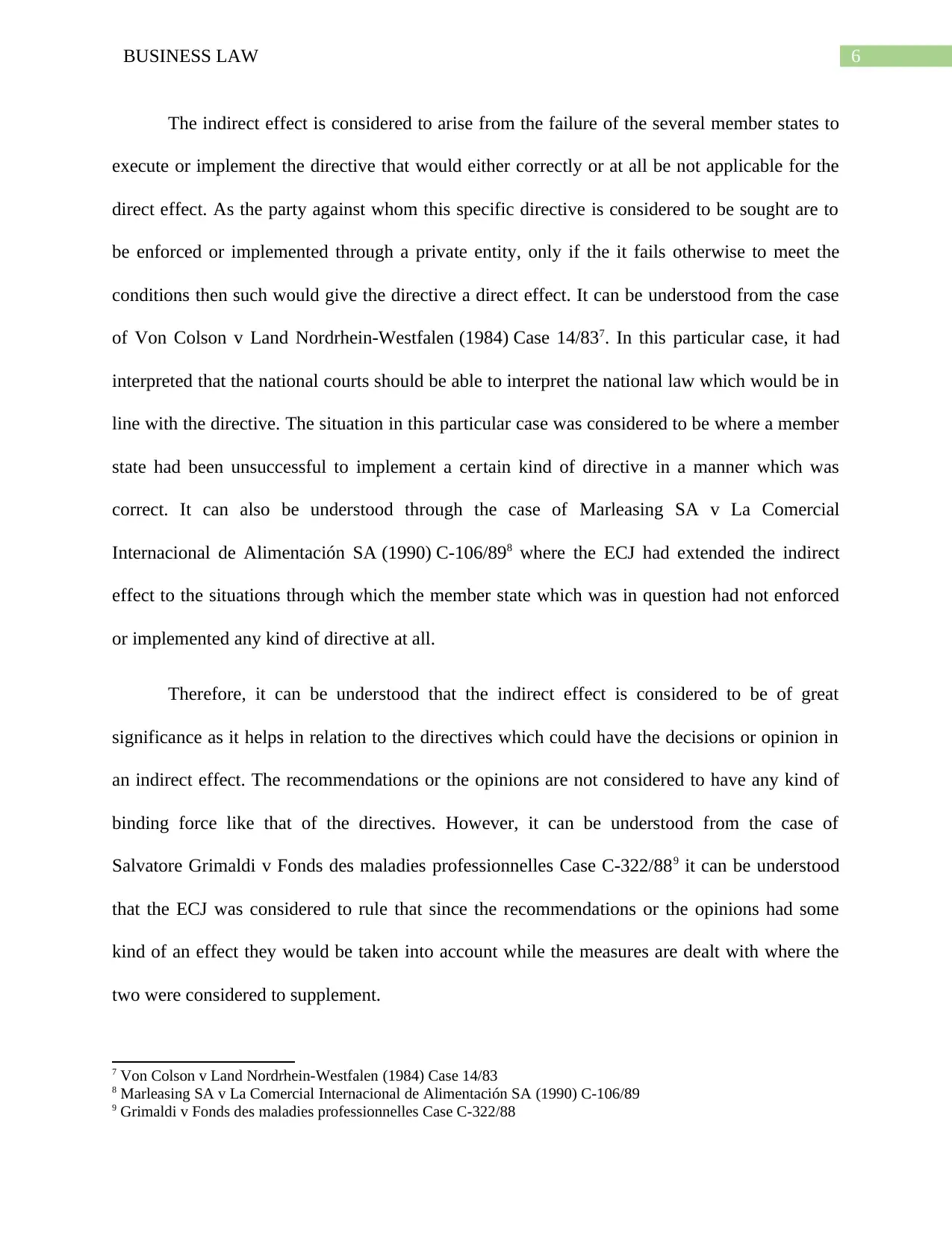
6BUSINESS LAW
The indirect effect is considered to arise from the failure of the several member states to
execute or implement the directive that would either correctly or at all be not applicable for the
direct effect. As the party against whom this specific directive is considered to be sought are to
be enforced or implemented through a private entity, only if the it fails otherwise to meet the
conditions then such would give the directive a direct effect. It can be understood from the case
of Von Colson v Land Nordrhein-Westfalen (1984) Case 14/837. In this particular case, it had
interpreted that the national courts should be able to interpret the national law which would be in
line with the directive. The situation in this particular case was considered to be where a member
state had been unsuccessful to implement a certain kind of directive in a manner which was
correct. It can also be understood through the case of Marleasing SA v La Comercial
Internacional de Alimentación SA (1990) C-106/898 where the ECJ had extended the indirect
effect to the situations through which the member state which was in question had not enforced
or implemented any kind of directive at all.
Therefore, it can be understood that the indirect effect is considered to be of great
significance as it helps in relation to the directives which could have the decisions or opinion in
an indirect effect. The recommendations or the opinions are not considered to have any kind of
binding force like that of the directives. However, it can be understood from the case of
Salvatore Grimaldi v Fonds des maladies professionnelles Case C-322/889 it can be understood
that the ECJ was considered to rule that since the recommendations or the opinions had some
kind of an effect they would be taken into account while the measures are dealt with where the
two were considered to supplement.
7 Von Colson v Land Nordrhein-Westfalen (1984) Case 14/83
8 Marleasing SA v La Comercial Internacional de Alimentación SA (1990) C-106/89
9 Grimaldi v Fonds des maladies professionnelles Case C-322/88
The indirect effect is considered to arise from the failure of the several member states to
execute or implement the directive that would either correctly or at all be not applicable for the
direct effect. As the party against whom this specific directive is considered to be sought are to
be enforced or implemented through a private entity, only if the it fails otherwise to meet the
conditions then such would give the directive a direct effect. It can be understood from the case
of Von Colson v Land Nordrhein-Westfalen (1984) Case 14/837. In this particular case, it had
interpreted that the national courts should be able to interpret the national law which would be in
line with the directive. The situation in this particular case was considered to be where a member
state had been unsuccessful to implement a certain kind of directive in a manner which was
correct. It can also be understood through the case of Marleasing SA v La Comercial
Internacional de Alimentación SA (1990) C-106/898 where the ECJ had extended the indirect
effect to the situations through which the member state which was in question had not enforced
or implemented any kind of directive at all.
Therefore, it can be understood that the indirect effect is considered to be of great
significance as it helps in relation to the directives which could have the decisions or opinion in
an indirect effect. The recommendations or the opinions are not considered to have any kind of
binding force like that of the directives. However, it can be understood from the case of
Salvatore Grimaldi v Fonds des maladies professionnelles Case C-322/889 it can be understood
that the ECJ was considered to rule that since the recommendations or the opinions had some
kind of an effect they would be taken into account while the measures are dealt with where the
two were considered to supplement.
7 Von Colson v Land Nordrhein-Westfalen (1984) Case 14/83
8 Marleasing SA v La Comercial Internacional de Alimentación SA (1990) C-106/89
9 Grimaldi v Fonds des maladies professionnelles Case C-322/88
Paraphrase This Document
Need a fresh take? Get an instant paraphrase of this document with our AI Paraphraser
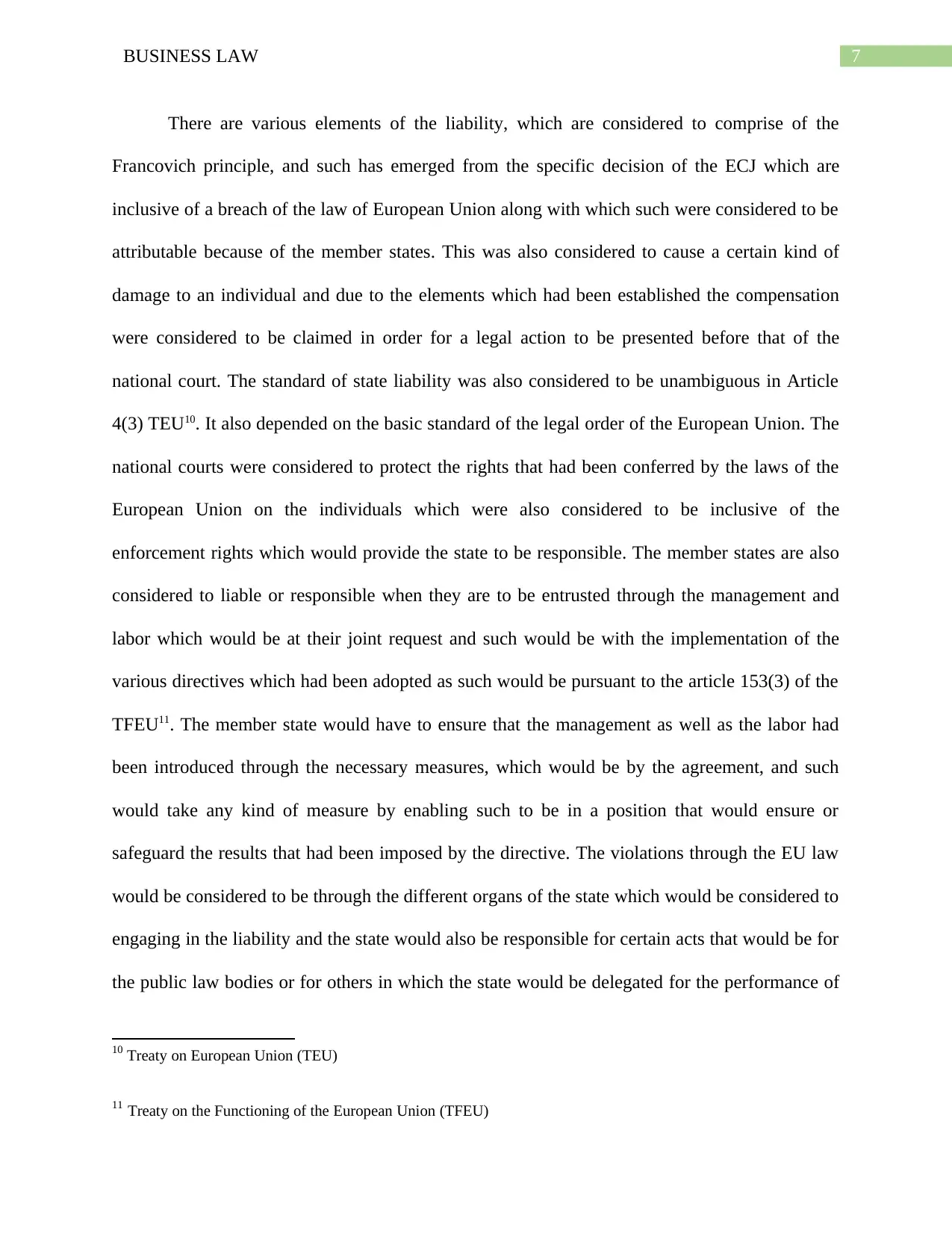
7BUSINESS LAW
There are various elements of the liability, which are considered to comprise of the
Francovich principle, and such has emerged from the specific decision of the ECJ which are
inclusive of a breach of the law of European Union along with which such were considered to be
attributable because of the member states. This was also considered to cause a certain kind of
damage to an individual and due to the elements which had been established the compensation
were considered to be claimed in order for a legal action to be presented before that of the
national court. The standard of state liability was also considered to be unambiguous in Article
4(3) TEU10. It also depended on the basic standard of the legal order of the European Union. The
national courts were considered to protect the rights that had been conferred by the laws of the
European Union on the individuals which were also considered to be inclusive of the
enforcement rights which would provide the state to be responsible. The member states are also
considered to liable or responsible when they are to be entrusted through the management and
labor which would be at their joint request and such would be with the implementation of the
various directives which had been adopted as such would be pursuant to the article 153(3) of the
TFEU11. The member state would have to ensure that the management as well as the labor had
been introduced through the necessary measures, which would be by the agreement, and such
would take any kind of measure by enabling such to be in a position that would ensure or
safeguard the results that had been imposed by the directive. The violations through the EU law
would be considered to be through the different organs of the state which would be considered to
engaging in the liability and the state would also be responsible for certain acts that would be for
the public law bodies or for others in which the state would be delegated for the performance of
10 Treaty on European Union (TEU)
11 Treaty on the Functioning of the European Union (TFEU)
There are various elements of the liability, which are considered to comprise of the
Francovich principle, and such has emerged from the specific decision of the ECJ which are
inclusive of a breach of the law of European Union along with which such were considered to be
attributable because of the member states. This was also considered to cause a certain kind of
damage to an individual and due to the elements which had been established the compensation
were considered to be claimed in order for a legal action to be presented before that of the
national court. The standard of state liability was also considered to be unambiguous in Article
4(3) TEU10. It also depended on the basic standard of the legal order of the European Union. The
national courts were considered to protect the rights that had been conferred by the laws of the
European Union on the individuals which were also considered to be inclusive of the
enforcement rights which would provide the state to be responsible. The member states are also
considered to liable or responsible when they are to be entrusted through the management and
labor which would be at their joint request and such would be with the implementation of the
various directives which had been adopted as such would be pursuant to the article 153(3) of the
TFEU11. The member state would have to ensure that the management as well as the labor had
been introduced through the necessary measures, which would be by the agreement, and such
would take any kind of measure by enabling such to be in a position that would ensure or
safeguard the results that had been imposed by the directive. The violations through the EU law
would be considered to be through the different organs of the state which would be considered to
engaging in the liability and the state would also be responsible for certain acts that would be for
the public law bodies or for others in which the state would be delegated for the performance of
10 Treaty on European Union (TEU)
11 Treaty on the Functioning of the European Union (TFEU)
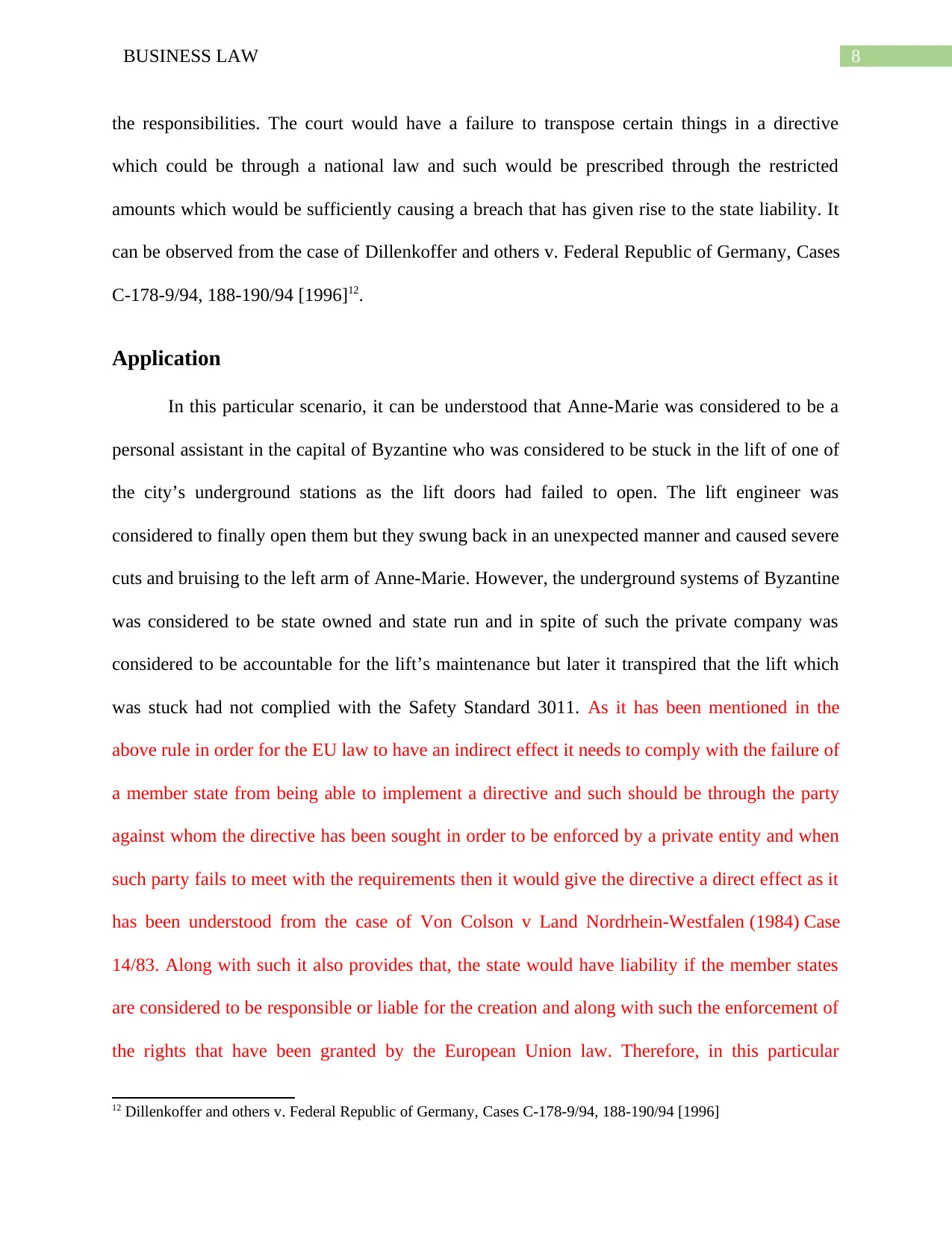
8BUSINESS LAW
the responsibilities. The court would have a failure to transpose certain things in a directive
which could be through a national law and such would be prescribed through the restricted
amounts which would be sufficiently causing a breach that has given rise to the state liability. It
can be observed from the case of Dillenkoffer and others v. Federal Republic of Germany, Cases
C-178-9/94, 188-190/94 [1996]12.
Application
In this particular scenario, it can be understood that Anne-Marie was considered to be a
personal assistant in the capital of Byzantine who was considered to be stuck in the lift of one of
the city’s underground stations as the lift doors had failed to open. The lift engineer was
considered to finally open them but they swung back in an unexpected manner and caused severe
cuts and bruising to the left arm of Anne-Marie. However, the underground systems of Byzantine
was considered to be state owned and state run and in spite of such the private company was
considered to be accountable for the lift’s maintenance but later it transpired that the lift which
was stuck had not complied with the Safety Standard 3011. As it has been mentioned in the
above rule in order for the EU law to have an indirect effect it needs to comply with the failure of
a member state from being able to implement a directive and such should be through the party
against whom the directive has been sought in order to be enforced by a private entity and when
such party fails to meet with the requirements then it would give the directive a direct effect as it
has been understood from the case of Von Colson v Land Nordrhein-Westfalen (1984) Case
14/83. Along with such it also provides that, the state would have liability if the member states
are considered to be responsible or liable for the creation and along with such the enforcement of
the rights that have been granted by the European Union law. Therefore, in this particular
12 Dillenkoffer and others v. Federal Republic of Germany, Cases C-178-9/94, 188-190/94 [1996]
the responsibilities. The court would have a failure to transpose certain things in a directive
which could be through a national law and such would be prescribed through the restricted
amounts which would be sufficiently causing a breach that has given rise to the state liability. It
can be observed from the case of Dillenkoffer and others v. Federal Republic of Germany, Cases
C-178-9/94, 188-190/94 [1996]12.
Application
In this particular scenario, it can be understood that Anne-Marie was considered to be a
personal assistant in the capital of Byzantine who was considered to be stuck in the lift of one of
the city’s underground stations as the lift doors had failed to open. The lift engineer was
considered to finally open them but they swung back in an unexpected manner and caused severe
cuts and bruising to the left arm of Anne-Marie. However, the underground systems of Byzantine
was considered to be state owned and state run and in spite of such the private company was
considered to be accountable for the lift’s maintenance but later it transpired that the lift which
was stuck had not complied with the Safety Standard 3011. As it has been mentioned in the
above rule in order for the EU law to have an indirect effect it needs to comply with the failure of
a member state from being able to implement a directive and such should be through the party
against whom the directive has been sought in order to be enforced by a private entity and when
such party fails to meet with the requirements then it would give the directive a direct effect as it
has been understood from the case of Von Colson v Land Nordrhein-Westfalen (1984) Case
14/83. Along with such it also provides that, the state would have liability if the member states
are considered to be responsible or liable for the creation and along with such the enforcement of
the rights that have been granted by the European Union law. Therefore, in this particular
12 Dillenkoffer and others v. Federal Republic of Germany, Cases C-178-9/94, 188-190/94 [1996]
⊘ This is a preview!⊘
Do you want full access?
Subscribe today to unlock all pages.

Trusted by 1+ million students worldwide
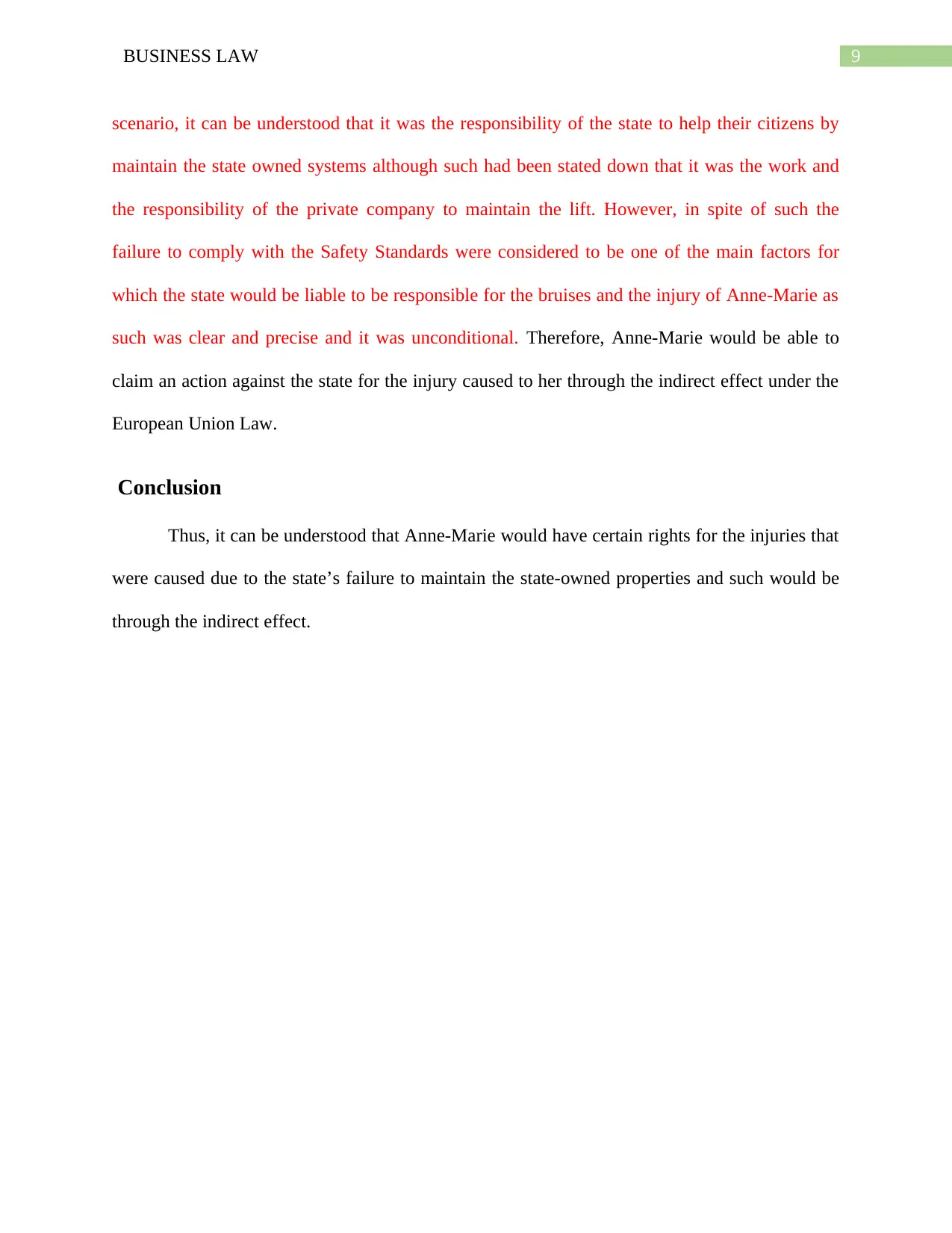
9BUSINESS LAW
scenario, it can be understood that it was the responsibility of the state to help their citizens by
maintain the state owned systems although such had been stated down that it was the work and
the responsibility of the private company to maintain the lift. However, in spite of such the
failure to comply with the Safety Standards were considered to be one of the main factors for
which the state would be liable to be responsible for the bruises and the injury of Anne-Marie as
such was clear and precise and it was unconditional. Therefore, Anne-Marie would be able to
claim an action against the state for the injury caused to her through the indirect effect under the
European Union Law.
Conclusion
Thus, it can be understood that Anne-Marie would have certain rights for the injuries that
were caused due to the state’s failure to maintain the state-owned properties and such would be
through the indirect effect.
scenario, it can be understood that it was the responsibility of the state to help their citizens by
maintain the state owned systems although such had been stated down that it was the work and
the responsibility of the private company to maintain the lift. However, in spite of such the
failure to comply with the Safety Standards were considered to be one of the main factors for
which the state would be liable to be responsible for the bruises and the injury of Anne-Marie as
such was clear and precise and it was unconditional. Therefore, Anne-Marie would be able to
claim an action against the state for the injury caused to her through the indirect effect under the
European Union Law.
Conclusion
Thus, it can be understood that Anne-Marie would have certain rights for the injuries that
were caused due to the state’s failure to maintain the state-owned properties and such would be
through the indirect effect.
Paraphrase This Document
Need a fresh take? Get an instant paraphrase of this document with our AI Paraphraser
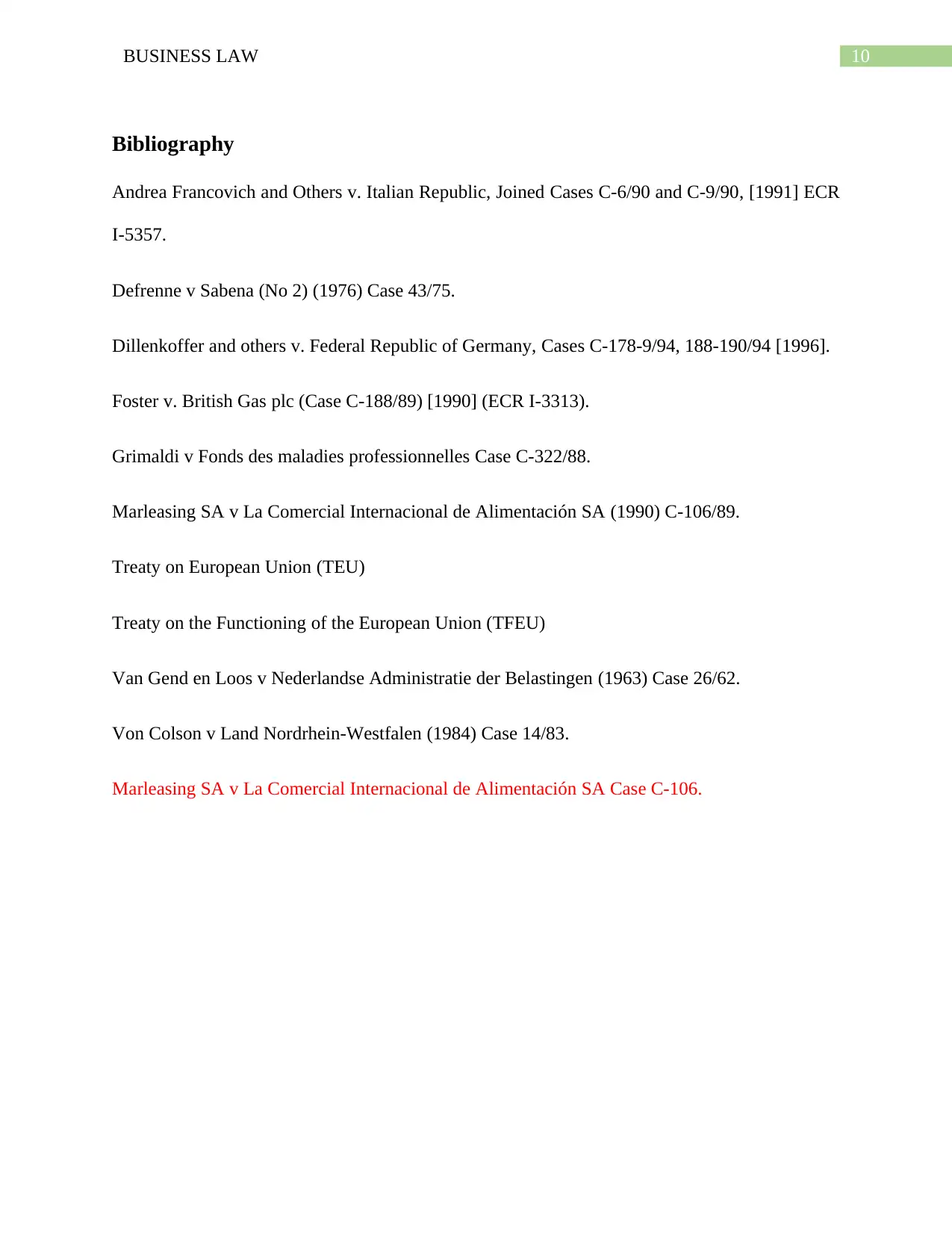
10BUSINESS LAW
Bibliography
Andrea Francovich and Others v. Italian Republic, Joined Cases C-6/90 and C-9/90, [1991] ECR
I-5357.
Defrenne v Sabena (No 2) (1976) Case 43/75.
Dillenkoffer and others v. Federal Republic of Germany, Cases C-178-9/94, 188-190/94 [1996].
Foster v. British Gas plc (Case C-188/89) [1990] (ECR I-3313).
Grimaldi v Fonds des maladies professionnelles Case C-322/88.
Marleasing SA v La Comercial Internacional de Alimentación SA (1990) C-106/89.
Treaty on European Union (TEU)
Treaty on the Functioning of the European Union (TFEU)
Van Gend en Loos v Nederlandse Administratie der Belastingen (1963) Case 26/62.
Von Colson v Land Nordrhein-Westfalen (1984) Case 14/83.
Marleasing SA v La Comercial Internacional de Alimentación SA Case C-106.
Bibliography
Andrea Francovich and Others v. Italian Republic, Joined Cases C-6/90 and C-9/90, [1991] ECR
I-5357.
Defrenne v Sabena (No 2) (1976) Case 43/75.
Dillenkoffer and others v. Federal Republic of Germany, Cases C-178-9/94, 188-190/94 [1996].
Foster v. British Gas plc (Case C-188/89) [1990] (ECR I-3313).
Grimaldi v Fonds des maladies professionnelles Case C-322/88.
Marleasing SA v La Comercial Internacional de Alimentación SA (1990) C-106/89.
Treaty on European Union (TEU)
Treaty on the Functioning of the European Union (TFEU)
Van Gend en Loos v Nederlandse Administratie der Belastingen (1963) Case 26/62.
Von Colson v Land Nordrhein-Westfalen (1984) Case 14/83.
Marleasing SA v La Comercial Internacional de Alimentación SA Case C-106.
1 out of 11
Related Documents
Your All-in-One AI-Powered Toolkit for Academic Success.
+13062052269
info@desklib.com
Available 24*7 on WhatsApp / Email
![[object Object]](/_next/static/media/star-bottom.7253800d.svg)
Unlock your academic potential
Copyright © 2020–2025 A2Z Services. All Rights Reserved. Developed and managed by ZUCOL.





